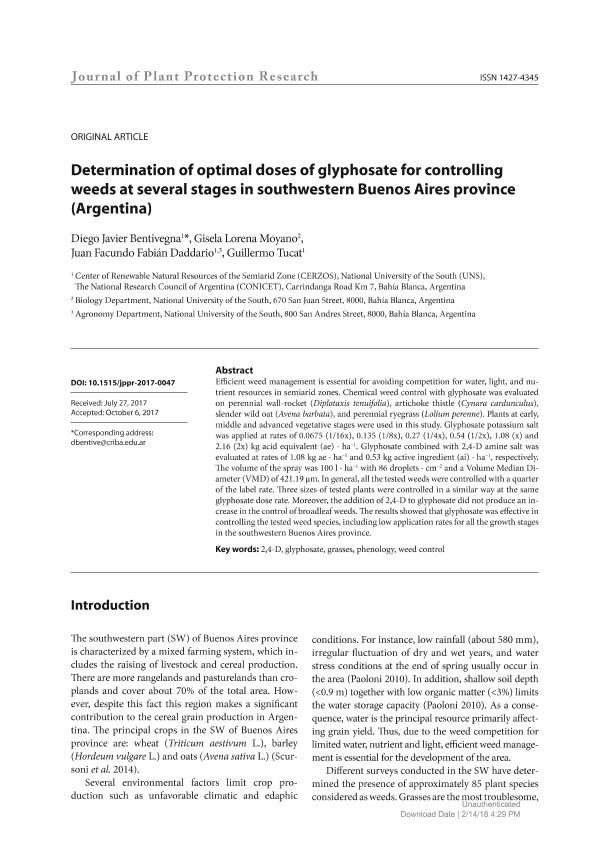Artículo
Determination of optimal doses of glyphosate for controlling weeds at several stages in southwestern Buenos Aires province (Argentina)
Fecha de publicación:
19/01/2018
Editorial:
Polish Academy of Sciences
Revista:
Journal of Plant Protection Research
ISSN:
1899-007X
e-ISSN:
1427-4345
Idioma:
Inglés
Tipo de recurso:
Artículo publicado
Clasificación temática:
Resumen
Efficient weed management is essential for avoiding competition for water, light, and nutrient resources in semiarid zones. Chemical weed control with glyphosate was evaluated on perennial wall-rocket (Diplotaxis tenuifolia), artichoke thistle (Cynara cardunculus), slender wild oat (Avena barbata), and perennial ryegrass (Lolium perenne). Plants at early, middle and advanced vegetative stages were used in this study. Glyphosate potassium salt was applied at rates of 0.0675 (1/16x), 0.135 (1/8x), 0.27 (1/4x), 0.54 (1/2x), 1.08 (x) and 2.16 (2x) kg acid equivalent (ae) · ha-1. Glyphosate combined with 2,4-D amine salt was evaluated at rates of 1.08 kg ae · ha-1 0.53-1 kg active ingredient (ai) · ha with 86-1 droplets · cm-2 respectively. The volume of the spray was 100 l · ha-1 a Volume Median Diameter (VMD) of 421.19 μm. In general, all the tested weeds were controlled with a quarter of the label rate. Three sizes of tested plants were controlled in a similar way at the same glyphosate dose rate. Moreover, the addition of 2,4-D to glyphosate did not produce an increase in the control of broadleaf weeds. The results showed that glyphosate was effective in controlling the tested weed species, including low application rates for all the growth stages in the southwestern Buenos Aires province.
Palabras clave:
2,4-D
,
Glyphosate
,
Grasses
,
Phenology
,
Weed Control
Archivos asociados
Licencia
Identificadores
Colecciones
Articulos(CERZOS)
Articulos de CENTRO REC.NAT.RENOVABLES DE ZONA SEMIARIDA(I)
Articulos de CENTRO REC.NAT.RENOVABLES DE ZONA SEMIARIDA(I)
Citación
Bentivegna, Diego Javier; Moyano, Gisela Lorena; Daddario, Juan Facundo Fabian; Tucat, Guillermo; Determination of optimal doses of glyphosate for controlling weeds at several stages in southwestern Buenos Aires province (Argentina); Polish Academy of Sciences; Journal of Plant Protection Research; 57; 4; 19-1-2018; 347-354
Compartir
Altmétricas




